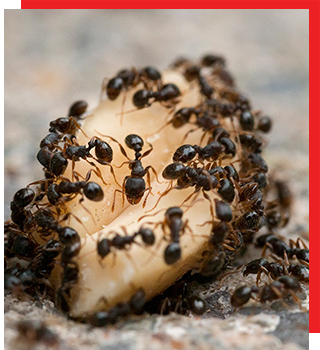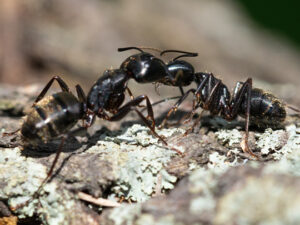
Whether they’re swarming your picnic or marching through your kitchen, ants are the tiny neighbors that few homeowners enjoy sharing their space with. But did you know there are over 100 species of ants in New York State? Each has unique behaviors, habitats, and characteristics, making some more problematic than others for residents and businesses.
This guide will introduce you to the most common ant species found in New York State, including how to identify them, their habits, and tips for managing infestations. By the end, you’ll know exactly who your six-legged visitors are and how to handle them.
Why You Should Care About Ant Identification
Knowing the kind of ant you’re dealing with isn’t just trivia—it’s essential for effective pest control. Different species of ants have varied diets, nesting habits, and behaviors. While some are merely a nuisance, others can damage property or spread bacteria.
For example:
- Carpenter ants can cause structural damages to wooden furniture and homes.
- Pharaoh ants pose health risks and can spread harmful pathogens.
- Pavement ants, while relatively harmless, can infest kitchens in large numbers if left unchecked.
Understanding their habits is the first step in keeping your home ant-free.
Meet the Most Common Ant Species in New York State
1. Carpenter Ants (Camponotus spp.)
Appearance
- Size: ¼ to ½ inch long
- Color: Black or sometimes reddish-brown
Where They Live
Carpenter ants are often found near wood, nesting in decaying trees, stumps, or wooden structures like beams within homes. Unlike termites, they don’t eat wood but excavate it to create tunnels for nesting.
Why They’re a Problem
Carpenter ants can weaken wooden structures over time, causing significant damage if left untreated.
How to Handle Them
To manage an infestation, look for sawdust-like debris near wood and use bait stations or professional-grade insecticides. Fix moisture issues, as damp environments attract these ants.
2. Pavement Ants (Tetramorium caespitum)
Appearance
- Size: ⅛ inch long
- Color: Brown to black
Where They Live
True to their name, pavement ants nest under sidewalks, driveways, and patios. During warmer months, they can invade homes in search of food.
Why They’re a Problem
Pavement ants generally forage for sugary or greasy foods, often making their way into kitchens. While not aggressive, their foraging trails can become unsightly and unsanitary.
How to Handle Them
Seal food tightly and clean up spills immediately. Use bait stations to eliminate the colony at its source.
3. Pharaoh Ants (Monomorium pharaonis)
Appearance
- Size: 1/16 inch long
- Color: Light yellow or reddish
Where They Live
Pharaoh ants prefer warm indoor environments, such as near heating pipes, pantries, or kitchens. They frequently establish large colonies in restaurants or hospitals.
Why They’re a Problem
These tiny ants can spread pathogens like Salmonella and Streptococcus, posing health risks. They are particularly challenging due to their ability to split colonies into multiple satellite nests if not properly controlled.
How to Handle Them
Pharaoh ants often require professional pest control. DIY sprays can make infestations worse by triggering colony splitting, so baiting is the preferred method.
4. Odorous House Ants (Tapinoma sessile)
Appearance
- Size: 1/16 to ⅛ inch long
- Color: Dark brown or black
Where They Live
These ants thrive both indoors and outdoors. They often nest under rocks, in wall voids, or in moist areas near water sources.
Why They’re a Problem
Odorous house ants get their name from the unpleasant, rotten odor they emit when crushed. They regularly invade homes, foraging for sweet and greasy foods.
How to Handle Them
Clean kitchens regularly, remove crumbs, and store food in airtight containers. Use non-repellent bait for effective control.
5. Acrobat Ants (Crematogaster spp.)
Appearance
- Size: 1/16 to ⅛ inch long
- Color: Light brown to black with a distinctive heart-shaped abdomen
Where They Live
Acrobat ants nest in decayed wood, under stones, or in old termite galleries. Indoors, they enjoy damp environments like bathroom walls or water-damaged wood.
Why They’re a Problem
These ants protect themselves aggressively, producing a foul odor when threatened. They can also strip electrical wiring insulation, causing costly repairs.
How to Handle Them
Eliminate water damage and seal entry points. Use bait specifically designed for acrobat ants for targeted extermination.
6. Field Ants (Formica spp.)
Appearance
- Size: ¼ inch long
- Color: Black, reddish, or a mix of the two
Where They Live
Field ants are found outdoors in grassy areas, building large, dome-shaped mounds. They rarely invade homes but may be seen foraging.
Why They’re a Problem
While harmless indoors, they can damage lawns and gardens with their extensive mounding.
How to Handle Them
Rake their mounds flat and use a direct contact insecticide around their nesting site to control populations
Preventing Ant Infestations in Your Home
Prevention is the best strategy when it comes to dealing with ants. Here are some expert-approved tips for keeping your home ant-free:
- Keep Your Home Clean: Tidy up crumbs, spills, and dirty dishes to avoid attracting foraging ants.
- Seal Entry Points: Inspect windows, doors, and cracks in your foundation and seal any visible gaps.
- Eliminate Moisture: Repair leaky pipes, clogged gutters, and other damp areas that insects love.
- Store Food Properly: Use sealed containers for pantry items, especially sugary and greasy foods.
- Treat the Exterior: Apply outdoor bait stations around your home during peak ant activity (typically spring and summer).
By staying proactive, you can minimize the likelihood of an ant problems even in high-risk areas.
Call in the Experts When Needed
When DIY prevention or removal isn’t enough, professional pest control services can provide advanced treatments to eliminate colonies. Companies specializing in ant management can target infestations more efficiently, giving you peace of mind.
Say Goodbye to Uninvited Guests
Ants can go from mildly annoying to downright destructive if left unchecked. By learning to identify the most common ant species in New York State and understanding their behaviors, you’ll be better equipped to manage infestations before they escalate.
Have you been battling an ant problem? Share your experiences or favorite remedies in the comments below! Together, we can turn the tide against these miniature invaders.










